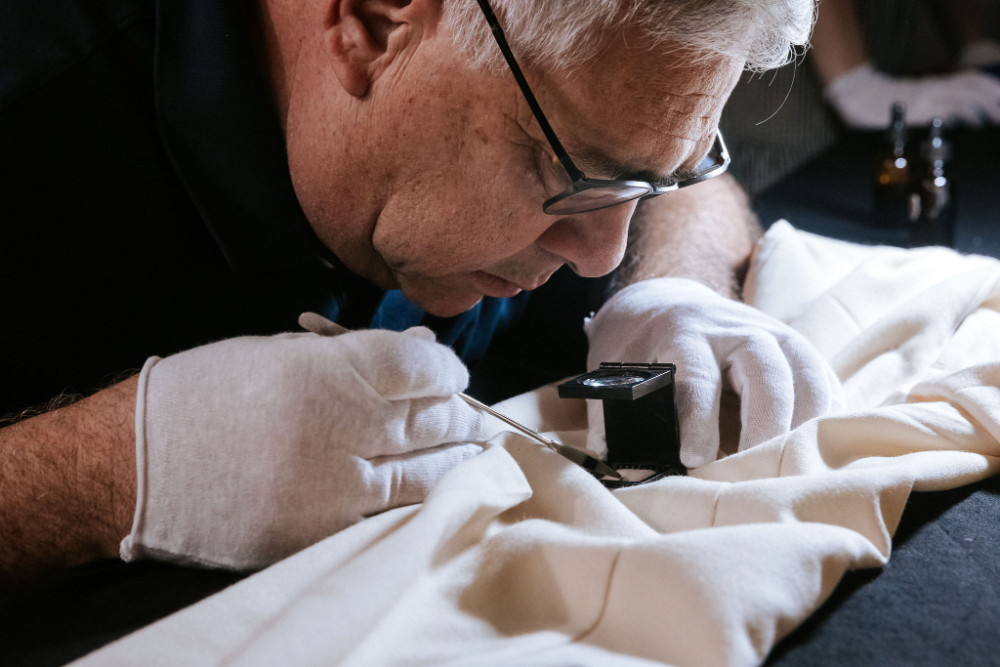A couture wedding gown is unlike any other garment you will ever own. These gowns are hand-crafted using the world’s finest materials — silk, lace, organza, delicate beadwork, sequins, embroidery, and hand-finished trims. They are designed to capture artistry and emotion, not to withstand harsh, industrial cleaning processes.
Unfortunately, most brides are unaware of the dangers of entrusting their gown to a standard dry cleaner. While these cleaners may be suitable for everyday garments, their methods can permanently harm couture gowns — sometimes in ways that only become apparent years later, when the gown has yellowed, seams have weakened, or embellishments have fallen away.
If your gown holds not just monetary value but profound sentimental importance, it’s critical to understand the risks — and the alternatives.
The Hidden Risks of Standard Dry Cleaning
Dry cleaners are built for efficiency. They focus on turning around garments quickly and in volume, often using the same solvents and machinery on suits, dresses, and couture wedding gowns alike. This “one-size-fits-all” approach is precisely what makes them dangerous.
Here are the most common ways dry cleaners damage couture gowns:
1. Harsh Solvents
Most cleaners use aggressive chemicals like perchloroethylene (perc) or petroleum-based solvents.
- Result: Dyes can bleed or shift, fibers weaken and become brittle, and glue-mounted beads or sequins may dissolve or fall off.
2. Immersion Without Testing
Gowns are often submerged without testing how fabrics, trims, and embellishments react.
- Result: Silks shrink, lace distorts, bias cuts warp, and stains may spread instead of being removed.
3. Mechanical Agitation
Dry-cleaning machines tumble gowns with harsh motion.
- Result: Lace tears, embroidery frays, and delicate seams rip under stress.
4. Aggressive Spot Treatments
Strong alkaline or oxidizing spot removers (like bleach or ammonia) are commonly used.
- Result: Yellowed or burned patches on silk, loss of sheen, and long-term fiber weakness.
5. Heat Damage
Commercial dryers and steam presses rely on high heat.
- Result: Shrinkage of linings, melted sequins, and flattened bodices.
6. Ignoring Complex Couture Construction
Couture gowns are engineered with hidden structural elements — corsetry, boning, netting, and layered underskirts. Most cleaners overlook them.
- Result: Collapsed bodices, warped silhouettes, and weakened underlayers.
7. Residual Stains in Storage
Dry cleaning often fails to remove invisible residues (like sugar from champagne).
- Result: Months or years later, these residues oxidize into brown or yellow stains, permanently damaging the fabric.
This visual guide illustrates the sharp contrast between standard dry cleaning and museum-quality conservation cleaning, helping brides see exactly what’s at stake.
Why Low-Cost Cleaners Are a Risky Gamble
It’s tempting to choose a budget wedding gown cleaner, especially when the price difference can be hundreds of dollars. But the reality is this: low-cost cleaners are not preservation experts.
- They use bulk cleaning methods, processing multiple gowns in the same cycle.
- They rarely test for dye stability or trim sensitivity before cleaning.
- Their focus is appearance, not long-term preservation.
- Packaging often involves plastic boxes or cardboard with “viewing windows,” which accelerate yellowing and trap moisture.
The gown may look clean when you pick it up, but five years later, it could emerge from storage yellowed, brittle, or irreparably damaged. Restoration at that point can cost thousands of dollars — and in some cases, may not be possible at all.
The Long-Term Value of Conservation Cleaning
Conservation cleaning is not about quick results. It’s about protecting the gown’s fibers, dyes, embellishments, and structure so it remains stable for decades. This approach is drawn from the same methods museums use to protect centuries-old textiles.
Here’s why it matters:
- Invisible stains are neutralized, not ignored. Future yellowing is prevented.
- Fabric integrity is reinforced. Fragile seams or embellishments are stabilized before cleaning.
- Archival packaging ensures safe storage. Acid-free boxes and unbuffered tissue allow fabrics to breathe, unlike plastic.
- Heirloom quality is preserved. Whether you plan to pass the gown down or simply cherish it yourself, it will remain intact.
The J. Scheer & Co. Difference
At J. Scheer & Co., we don’t just clean gowns — we conserve them. Our process is rooted in museum-quality textile conservation, ensuring each gown receives the care it deserves:
- Detailed Pre-Inspection
Every gown is carefully assessed for weak seams, dye stability, embellishment durability, and existing damage. - Hand Cleaning with Conservation Solutions
Each fabric and trim is treated individually with pH-neutral solutions, avoiding harsh chemicals and machine tumbling. - Targeted Stain Neutralization
Visible and invisible stains are treated to prevent future discoloration. - Gentle Finishing
Pleats, ruching, and 3D design details are preserved with careful steaming and protective barriers. - Archival Packaging
Gowns are returned in breathable, acid-free boxes with unbuffered tissue, never plastic.
Cost vs. Risk: A Practical Comparison
- Low-Cost Cleaner
- Price: $400–$800 upfront
- Risks: High chance of yellowing, bead loss, shrinkage, and distortion
- Future restoration: $1,500–$3,000+ (if salvageable)
- Price: $400–$800 upfront
- J. Scheer & Co.
- Price: Starting at $795, depending on gown complexity
- Benefits: Long-term preservation, archival storage, stable heirloom quality
- Future costs: Minimal, since conservation prevents damage
- Price: Starting at $795, depending on gown complexity
A couture wedding gown is not just fabric — it’s a memory, a piece of history, and often an heirloom meant to be treasured for generations. Standard dry cleaning treats it like any other garment, exposing it to harsh solvents, mechanical stress, and poor storage methods that can permanently alter its beauty.
Conservation cleaning, as practiced by J. Scheer & Co., is different. It’s a process rooted in science, artistry, and preservation — the only safe choice for gowns made of silk, lace, vintage textiles, or intricate embellishments.
Your gown deserves more than cleaning. It deserves conservation. Schedule a consultation with J. Scheer & Co. to ensure your gown remains as extraordinary decades from now as it was on the day you wore it.

